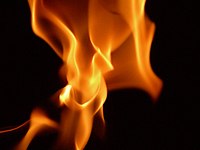
Photo from wikipedia
Abstract For flames with very low burning speed, the flame propagation is affected by buoyancy. Flame front evolution and laminar flame parameter evaluation methods of buoyancy-affected flame have been proposed.… Click to show full abstract
Abstract For flames with very low burning speed, the flame propagation is affected by buoyancy. Flame front evolution and laminar flame parameter evaluation methods of buoyancy-affected flame have been proposed. The evolution and propagation process of a center ignited expanding ammonia/air flame has been analyzed by using the methods. The laminar flame parameters of ammonia/air mixture under different equivalence ratio (ER) and initial pressure have been studied. At barometric pressure, with the increase of ER, the laminar burning velocity (LBV) of ammonia/air mixture undergoes a first increase and then decrease process and reaches its maximum value of 7.17 cm/s at the ER of 1.1, while the Markstein length increases monotonously. For ammonia/air flames with ER less than unity, the flame velocity shows a decreasing trend with stretch rate, resulting in the propensity to flame instability, but no cellular structure was observed in the process of flame propagation. As the initial pressure increases, the LBV decreases monotonously as well as the Markstein length. The flame thicknesses of ammonia/air mixtures decrease with initial pressure and are much thicker than those of hydrogen flames, which makes a stronger stabilizing effect of curvature on the flame front. The most enhancement of LBV is contributed by the dehydrogenation reaction of NH3 with OH. The NO concentration decreases significantly with the increase of ER.
Journal Title: International Journal of Hydrogen Energy
Year Published: 2021
Link to full text (if available)
Share on Social Media: Sign Up to like & get
recommendations!